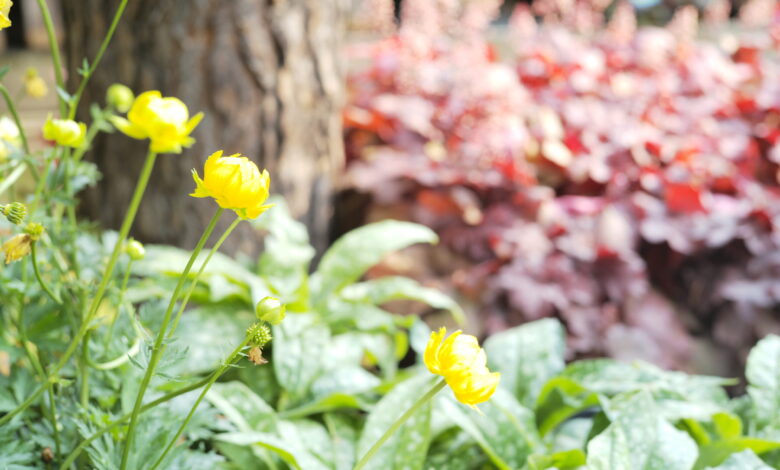19 Gardening and Landscaping Questions, Answered by an Expert

Last month I asked our Wit & Delight Instagram audience to share their gardening and landscaping questions with us. Well, friends, do I have answers. I was fortunate enough to speak with Jessie Jacobson, the owner and landscaping and gardening expert over at Tonkadale Greenhouse, one of my favorite places to visit. (Tonkadale is also the driving force behind my recent front yard update!). Jessie was kind enough to share some of her expertise in answering your top landscaping and gardening questions.
General Gardening Tips
Q: What is the #1 piece of gardening advice you wish people knew OR the #1 mistake you see most often?
A: Let’s not call them mistakes. Your intention is to plant plants and that is never a mistake. We definitely see gardeners get discouraged by trying to do too much at once. It’s always important to rely on the experts at your local garden center to make sure you plant the right plants for your location, amend your soil at the time of planting, and continue to water newly planted perennials, trees, and shrubs until the ground freezes solid in the fall.
Always remember, the joy is in the journey. Gardening is a thing you do over time—you learn as you go, gaining momentum from small successes.
Q: Will all plants bloom again if I prune after flowering?
A: No, not necessarily. Some perennials will give a second flush after pruning, but this is not the case with most. Plant a mix of perennials with early, mid, and late bloom times to ensure you always have color. Leave pockets for annual plants which provide flower power all season long!
Q: What are the hardest plants to kill?
A: This really depends on the application. Plants that are planted in the right location will thrive with proper planting and care during their first year of establishment. The easiest way to kill plants is to not provide enough water, especially after planting. From here, we can deduce that drought-tolerant plants are the hardest to kill! Perennials that tolerate drought include ornamental grasses, alliums, milkweed, echinacea, and many more. Check out this list of drought-tolerant plants!
Q: What are your tips for planting container gardens?
A: These are my main tips for thriving container gardens:
- Always start with rich, organic potting soil.
- Choose your foliage first. This provides the architecture for your design and provides color and interest even when flowering plants cycle in and out of color.
- Water, water, water.
- Fertilize with a bloom booster fertilizer at least weekly.
- Deadhead spent blooms and don’t be afraid to pinch and trim overgrown plants throughout the season.
Q: How do I plant a garden that looks professional without professional help?
A: Visit your local garden center and take advantage of their resources and customer service. Before you go, consider your answers to these questions:
- What do you want your garden to do for you or the environment?
- Are you interested in curb appeal/increased property value, energy conservation, cut flowers, entertaining, cooking, or planting for pollinators and songbirds?
- How much time do you want to spend in the garden each week and each season?
- What type of planting style do you prefer?
- Do you like cottage, contemporary, wild, or manicured gardens?
Generally speaking, I’d recommend starting with a small area, planting in multiples, choosing a color palette, varying bloom time, bloom size, and bloom shape, mixing perennials, trees, and shrubs, including evergreens, and leaving pockets for annuals and herbs.
Q: I have plants picked out but don’t know how to design a layout for the best visual impact. What is your advice?
A: Here’s what I suggest:
- Plant in mass, as this approach has the most visual impact.
- Group like plants together.
- Plant more of each variety, and fewer varieties in total.
- Make sure to include trees, shrubs, and evergreens in your plan. Single specimens offer a place for your eyes to rest.
- Consider adding sculptural elements like a path or a well-placed boulder.
Q: Hydrangea care! Are hydrangeas worth the investment?
A: Hydrangeas are always worth the investment! We have an amazing blog post, “All About Hydrangeas,” to answer all of your hydrangea questions!
Trees
Q: What are the best small trees to plant beside my home?
A: Trees planted near the home are considered foundational plantings. Trees and shrubs soften harsh architectural lines and can provide shade and insulation which promotes energy efficiency. Trees or shrubs planted close to the house should be smaller in stature, complementing the design of the house while not blocking windows or interesting features. Here is a list of trees and shrubs to consider:
- Serviceberry, specifically “Standing Ovation” or “Autumn Brilliance”
- Hydrangea bushes or standards
- Smaller evergreens (Look for the word dwarf or compact, or try Golden Hinoki False.)
- Cypress
- Golden Duke Eastern Hemlock
- Eastern redbud
- Pagoda dogwood
- Viburnum
- Lilacs, including Bloomerang, Miss Kim, Tiny Dancer
- Japanese maples
- Ginkgo Jade Butterfly
- Smoke bush
- Azalea/rhododendron
- Purple Leaf Sand Cherry
- Some crabapples
- Magnolia
- Boxwood
- Elderberry
Q: How do I know what to prune from mature trees and shrubs?
A: I’m not an expert on pruning trees, but I do know a bit about pruning shrubs. Here are the basics of pruning shrubs.
Pruning is done to improve the shrub’s appearance and help maintain its natural or manicured form, promote new growth, branching, and flowering, and promote overall plant health by improving airflow and removing dead or diseased branches.
New Wood or Old Wood
First, we need to know if our shrubs bloom on new wood or old wood. Shrubs that bloom on old wood set buds for next year at the end of the growing season. Prune these shrubs after flowering to encourage new flower bud formation. These are generally spring or early summer blooming shrubs including lilacs forsythia, mock orange, rhododendron, azalea, weigela, and ninebark.
Shrubs that bloom on new wood form buds on growth during the current growing season and tend to bloom mid to late summer. Prune shrubs that bloom on old wood in late winter or in early spring before the shrub has broken dormancy. Examples include panicle hydrangea, smooth hydrangea, summersweet, smoke bush, and roses.
Note that some newer shrub varieties provide blooms on new and old wood, including varieties of weigela such as the Sonic Bloom series, the Bloomerang series of lilac, and newer continuous blooming varieties of bigleaf hydrangea (Hydrangea macrophylla).
Pruning Tips
- Prune at a forty-five-degree angle right above a node or side branch with a clean, sharp pair of bypass pruners or loppers to ensure a clean and healthy cut. Pruning at an angle will allow water to run off the cut and prevent pooling that may encourage disease.
- Prune out any dead, broken, or diseased stems, spent blooms (if desired), rubbing branches, duplicate/parallel branches, and dense growth in the center of the shrub. Keep in mind the overall shape you desire in the process and keep the branches that will help develop or maintain that structure. Do not remove more than one-third of the plant at one time.
- Rejuvenation pruning can be done on well-established (at least three years old) shrubs to encourage a flush of healthy new growth, removing the oldest wood down to the ground.
Grass
Q: What is the best/easiest grass and/or plant to start from seed and maintain here in the Twin Cities?
A: Turfgrass is needy. Copious amounts of water and fertilizer are what keep grass looking full and fluffy. At Tonkadale we choose to sell grass seed that is certified by the Turfgrass Water Conservation Alliance. These grass mixes require up to 30% less inputs—less water, less fertilizer, less chemicals, and less mowing. Consider overseeding your lawn with this type of grass seed if you are interested in conservation-friendly turf.
Another option is to plant a bee lawn or native bee lawn mix. The bee lawn mix follows recommendations from the University of Minnesota, combining Dutch white clover, self-heal, and creeping thyme to create a seed mixture that can transform your lawn into a pollinator habitat while maintaining the function and recreation associated with a traditional lawn. The bee lawn seed mixture has been shown to support more than sixty bee species in Minnesota. Bee lawn flower seed can be overseeded into a pre-existing stand of healthy fine fescue or Kentucky bluegrass turf.
The native bee lawn mix uses all native wildflowers (self-heal, yaak yarrow, blue-eyed grass) to transform your home lawn into a beautiful mix of turfgrass and flowers. This seed mix is designed to reinforce the longstanding evolutionary relationships we observe in nature between pollinators and the native plants they depend on.
Read more about sustainable lawnscaping on Tonkadale’s blog.
Q: How do I start a garden where there is currently grass?
A: In this case, it is best to remove the grass first. You can remove turfgrass by hand with a shovel, but it’s so easy to rent a sod kicker from your local hardware store. If time is on your side, you can cover the area with plastic for several weeks to kill grass for easy removal by hand. Herbicides would not be our preferred method.
After the grass is removed, rent a tiller and work in compost at a rate of one cubic foot per ten square feet. Next, lay edging and then it’s time to plant!
Sun and Shade
Q: What are solutions for a bed where one part gets full sun and the other part gets full shade?
A: Totally different light requirements require totally different plants. If your garden space is continuous, there will be a transition zone that is part-sun. Use this area to plant things in common with both the sun and shade area. Many can tolerate a good amount of sun and still perform in a shady situation. Examples include astilbe, Japanese forest grass, heuchera, and hosta. Don’t worry about the sun and shade areas being a perfect match. Think more about the colors, textures, and structure you want to bring to each area.
Q: How do I stop a garden from dying in 110-degree weather?
A: Here are my tips on caring for a garden in the heat:
- Water. Water in the morning before the heat of the day to avoid evaporation.
- Depending on the duration of extreme heat, it might be time to plant drought-resistant plants, especially native plants that adapted to our climate.
- Place containers and hanging baskets in a shady area during a heat wave.
- Add mulch to garden beds to help retain moisture and keep the soil cool. If extreme heat is coupled with high humidity, evapotranspiration slows as does plant growth.
Q: What are the best shade plants other than hostas? I’m looking for something with color.
A: There are so many plants that are great for shade that offer color and interest both in foliage and flower. Some of our favorites include:
- Astilbe
- Aruncus/goat’s beard
- Solomon’s seal
- Ligularia
- Ferns
- Cimicifuga/snakeroot
- Bleeding heart
- Brunnera
- Chelone/turtlehead
- Pulmonaria/lungwort
- Polemonium/Jacob’s ladder
- Heuchera
- Filipendula
- Bergenia
- Epimedium
- Japanese forest grass
- Lady’s mantle
- Toad lily
Pests
Q: I’m terrified of jumping worms. How can I prevent/treat?!
A: Jumping worms are invasive worms that have made their way to the Twin Cities area through the transport of plants and soil. They can be very destructive, especially in major ecosystems as they change the structure of soil and strip it of nutrients.
My best advice is to purchase soil (bagged or bulk) and plants from reputable garden centers. The Minnesota Department of Natural Resources asks that you report sightings of jumping worms. Destroy and dispose of jumping worms if you find them. After they become established, there is not a whole lot you can do.
The fear of jumping worms is a real thing and can be labeled as solastalgia, which is the stress caused by environmental change. Many of us will experience distress over the implications of climate change, invasive species, and extreme weather events.
Read more about jumping worms by visiting the UMN Extension website.
Q: How can I prevent pests (rabbits) from eating new growth?
A: This is the best blog post ever! “How to Repel Deer and Rabbits in the Garden”
Eco-Conscious Gardening
Q: How can I be a responsible eco-conscious gardener (i.e., planting pollinator-friendly, native, and drought-tolerant plants)?
A: Just the fact that folks are thinking about this topic is a step in the right direction. If you are planting plants, you are already a responsible, eco-conscious gardener.
These are some must-read blog posts on the topic:
Q: How to plan a cohesive garden that blooms all season long?
A: Planting a garden for continuous color is not only appealing to us but also has great ecological benefits. Continuous color means a constant food source for pollinators and beneficial insects. Find out what blooms early, mid, and late in your area. At Tonkadale, we have a really great chart! Also, pay attention to what is blooming in your neighborhood or city over the course of the summer, then plant that!
Q: Real talk: How close are we to a zone 5 perennial surviving in the Twin Cities?
A: Perennial survival is most closely related to how long our lowest minimum temperatures are sustained. In the Twin Cities, we can hit temperatures as low as -30 degrees Fahrenheit which classifies us as Zone 4. Although the summers seem to be getting hotter, Zone 5 classification has more to do with winter lows than summer highs. In urban or protected areas, heat accumulates and gardeners in our area are able to have success with Zone 5 perennials, trees, and shrubs.
Editor’s Note: This post is sponsored by Tonkadale. The compensation we receive in exchange for placement on Wit & Delight is used to purchase props, hire a photographer, write/edit the blog post, and support the larger team behind Wit & Delight.
While compensation was received in exchange for coverage, all thoughts and opinions are always my own. Sponsored posts like these allow us to continue to develop dynamic unsponsored content. Thank you for supporting our partners!

Kate is the founder of Wit & Delight. She is currently learning how to play tennis and is forever testing the boundaries of her creative muscle. Follow her on Instagram at @witanddelight_.



